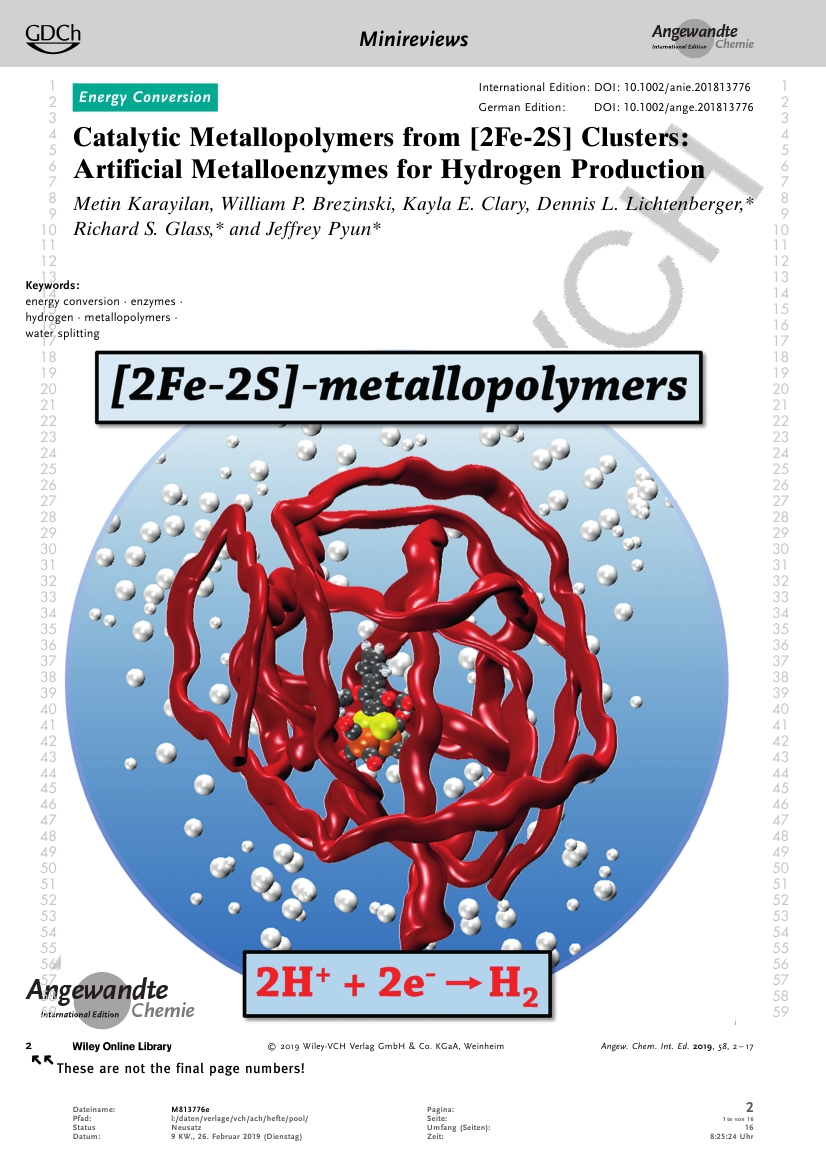Angewandte Chemie International Edition, Volume 58, Issue 11, 2019. 
Reviewed herein is the development of novel polymer-supported [2Fe- 2S] catalyst systems for electrocatalytic and photocatalytic hydrogen evolution reactions. [FeFe] hydrogenases are the best known naturally occurring metalloenzymes for hydrogen generation, and small-molecule, [2Fe-2S]-containing mimetics of the active site (H-cluster) of these metalloenzymes have been synthesized for years. These small [2Fe-2S] complexes have not yet reached the same capacity as that of enzymes for hydrogen production. Recently, modern polymer chemistry has been utilized to construct an outer coordination sphere around the [2Fe-2S] clusters to provide site isolation, water solubility, and improved catalytic activity. In this review, the various macromolecular motifs and the catalytic properties of these polymersupported [2Fe-2S] materials are surveyed. The most recent catalysts that incorporate a single [2Fe-2S] complex, termed single-site [2Fe-2S] metallopolymers, exhibit superior activity for H2 production.
Metin Karayilan, Dr. William P. Brezinski, Kayla E. Clary, Prof. Dennis L. Lichtenberger,* Prof. Richard S. Glass,* Prof. Jeffrey Pyun*r "Catalytic Metallopolymers from [2Fe-2S] Clusters: Artificial Metalloenzymes for Hydrogen Production" Angewandte Chemie International Edition 2019, 58, xxxx-xxxx. [http://dx.doi.org/10.1002/anie.201813776].
Organometallics, Volume 33, Issue 18, 2014. 
Much of the behavior of molecules can be viewed in terms of the movement of electrons. This view is obvious in the case of oxidation and reduction reactions, but so too catalysis can be viewed as the movement of electrons from one set of bonds to another, photophysical behaviors involve the movement of electrons between different energy levels and spatial distributions, and photovoltaics and molecular electronics depend on the transfer of electrons. Synthetic organometallic chemistry is making major strides in all of these areas and more. Electrochemistry represents a complementary approach to electron-transfer-initiated reactivity of organometallic compounds: instead of individual “classic” chemical oxidation/reduction agents, the electrode serves as a “clean” electron donor/acceptor. Moreover, its oxidation/reduction ability can be easily and continuously changed by the applied potential. Electrochemical experiments are thus rich in information concerning thermodynamics, kinetics, equilibria, reversibility, and mechanism. This issue brings together leading organometallic chemists and electrochemists to illustrate the breadth and power of electrochemical studies of organometallic compounds.
Jiří Ludvík, Dennis H. Evans, Dennis L. Lichtenberger " Introduction to the Special Issue on Organometallic Electrochemistry " Organometallics 2014, 33, 4513-4516. [http://dx.doi.org/10.1021/om5008709].

Journal of the American Chemical Society,Volume 136, Issue 1, 2014.
From curiosity to application: 50 years of the quadruple bond. Interaction of the π electrons of bicyclic guanidinates with the delta bond of ditungsten complexes gives rise to the lowest gas-phase ionization energy of any laboratory-prepared compound. Alkyl substituents on the guandinates provide soluble compounds in non-polar, non-protonated solvents for applications where extremely powerful stoichiometric reductants are needed.
Gina M. Chiarella, F. Albert Cotton, Jason C. Durivage, Dennis L. Lichtenberger and Carlos A. Murillo "Solubilizing the most Easily Ionized Molecules and Generating Powerful Reducing Agents." Journal of the American Chemical Society 2013, 135(47), 17889-17896. [http://dx.doi.org/10.1021/ja408291k]
Inorganic Chemistry, Volume 50, Issue 21, 2011. 
The electronic interactions between metals and dithiolenes are important in the biological processes of many metalloenzymes as well as in diverse chemical and material applications. Of special note is the ability of the dithiolene ligand to support metal centers in multiple coordination environments and oxidation states. To better understand the nature of metal–dithiolene electronic interactions, new capabilities in gas-phase core photoelectron spectroscopy for molecules with high sublimation temperatures have been developed and applied to a series of molecules of the type Cp2M(bdt) (Cp = η5-cyclopentadienyl, M = Ti, V, Mo, and bdt = benzenedithiolato). Comparison of the gas-phase core and valence ionization energy shifts provides a unique quantitative energy measure of valence orbital overlap interactions between the metal and the sulfur orbitals that is separated from the effects of charge redistribution. The results explain the large amount of sulfur character in the redox-active orbitals and the ‘leveling’ of oxidation state energies in metal–dithiolene systems. The experimentally determined orbital interaction energies reveal a previously unidentified overlap interaction of the predominantly sulfur HOMO of the bdt ligand with filled π orbitals of the Cp ligands, suggesting that direct dithiolene interactions with other ligands bound to the metal could be significant for other metal–dithiolene systems in chemistry and biology.
Wiebelhaus, N. J.; Cranswick, M. A.; Klein, E. L.; Lockett, L. T.; Lichtenberger, D. L.; Enemark, J. H. "Metal-Sulfur Valence Orbital Interaction Energies in Metal-Dithiolene Complexes: Determination of Charge and Overlap Interaction Energies by Comparison of Core and Valence Ionization Energy Shifts." Inorg. Chem. 2011, 50, 11021-11031 [http://dx.doi.org/10.1021/ic201566n].

Inorganic Chemistry, Volume 48, Issue 23, 2009.

Gas phase photoelectron spectroscopy and density functional theory calculations of (tBuO)3M≡N molecules reveal substantial changes in orbital orderings and characters with metal substitution down the transition metal group VIa. The nonbonding alkoxide a2 symmetry combination of oxygen p orbitals is the HOMO for the Cr complex, but this orbital stabilizes in the Mo and W complexes while a M≡N σ orbital destabilizes and becomes the HOMO, leading to the differences in physical and chemical properties of these metal–nitride molecules.
Chen, S.; Chisholm, M. H.; Davidson, E. R.; English, J. B.; Lichtenberger, D. L. "Theoretical and Spectroscopic Investigations of the Bonding and Reactivity of (RO)3M≡N Molecules, Where M = Cr, Mo, and W." Inorg. Chem. 2009, 48, 828-837 [http://dx.doi.org/10.1021/ic801786u].

Inorganic Chemistry, Volume 45, Issue 23, 2006.
Effective molecular catalysts for hydrogen production (as depicted in the schematic diagram) need to be active at potentials that are close to the thermodynamic standard potential for reduction of the proton source (acid) being studied. In this paper, standard potentials for the reduction of acids are reported, and it is shown that use of mercury electrodes suppresses direct reduction of the acid (dashed line in the display).
Felton, G. A. N.; Glass, R. S.; Lichtenberger, D. L.; Evans, D. H. "Iron-Only Hydrogenase Mimics. Thermodynamic Aspects of the use of Electrochemistry to Evaluate Catalytic Efficiency for Hydrogen Generation." Inorg. Chem. 2006, 45, 9181-9184 [http://dx.doi.org/10.1021/ic060984e].
